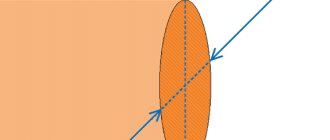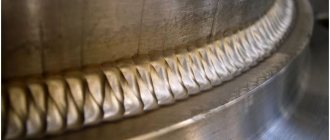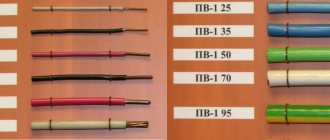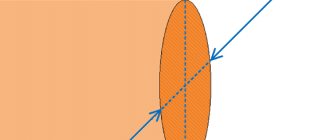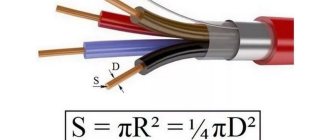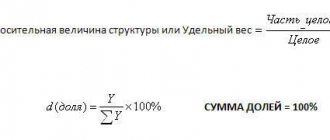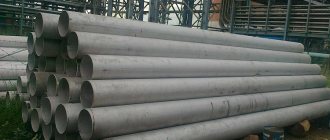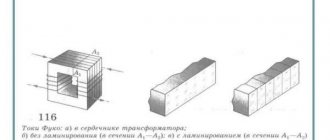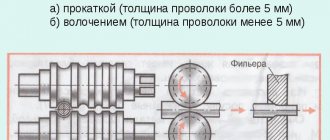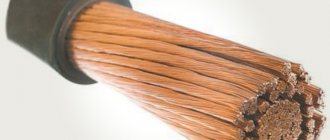It is now simply impossible to imagine the life of a modern person without electricity. But if you treat yourself negligently, it can become not a friend, but a deadly enemy. Even at the household level, the operation of electrical networks, systems and devices requires strict adherence to a number of immutable rules.
Calculation of cable cross-section for current
And, by the way, one of the most vulnerable places in the area of final consumption of electricity, that is, in residential buildings and apartments, is electrical wiring. Namely, an incorrect calculation of the cable cross-section based on the load current, which is why accidents most often occur with very serious and sometimes tragic consequences.
The problem is often that homeowners simply do not see the connection between the cross-section of the conductor and the power of the connected load: “current flows - and okay.” There are also situations when contractors clearly “scraped” during construction and, trying to save as much as possible on materials, secretly laid wires that were of poor quality or did not comply with the design. There are often cases where old wiring continues to be used; it may have been installed correctly, but once upon a time a very long time ago, that is, it is clearly not designed for the modern saturation of people’s lives with electrical household appliances.
This publication will consider several ways to assess the compliance of the conductor cross-section with the actual operating conditions of electrical appliances.
Cross-sectional area as an electrical quantity
The conductivity of the wire depends on the cross-section.
As an example of the cross-section, you can consider cutting the product at an angle of 90 degrees relative to the transverse axis. The outline of the resulting figure is determined by the configuration of the object. The cable looks like a small pipe, so when cut it will come out in the form of two circles of a certain thickness. When a round metal rod is cut transversely, the shape of a circle is obtained.
In electrical engineering, the PS area will mean the rectangular cross-section of the conductor in relation to its longitudinal part. The cross-section of the cores will always be round. The parameter is measured in mm2.
Novice electricians may confuse the diameter and cross-section of elements. To determine what cross-sectional area the core has, you need to take into account its round shape and use the formula:
S = πxR2, where:
- S – area of the circle;
- π – constant value 3.14;
- R is the radius of the circle.
If the area indicator is known, it is easy to find the resistivity of the manufacturing material and the length of the wire. Next, the current resistance is calculated.
For convenience of calculations, the initial formula is transformed:
- The radius is ½ the diameter.
- To calculate area, π is multiplied by D (diameter) divided by 4, or 0.8 multiplied by 2 diameters.
When calculating, use the diameter indicator, since its incorrect selection can cause overheating and ignition of the cable.
Dependence of current, power and core cross-section
When choosing a cable, you must be guided by several criteria:
- the strength of the electric current that the cable will pass;
- power consumed by energy sources;
- current load exerted on the cable.
Power
The most important parameter during electrical installation work (in particular, cable laying) is throughput. The maximum power of electricity transmitted through it depends on the cross-section of the conductor.
Therefore, it is extremely important to know the total power of the energy consumption sources that will be connected to the wire
Typically, manufacturers of household appliances, appliances and other electrical products indicate on the label and in the documentation accompanying them the maximum and average power consumption. For example, a washing machine can consume electricity ranging from tens of W/h during rinsing mode to 2.7 kW/h when heating water.
The average power of all electrical appliances and lighting devices in an apartment rarely exceeds 7500 W for a single-phase network. Accordingly, the cable cross-sections in the electrical wiring must be selected to this value.
On a note. It is recommended to round the cross-section towards higher power due to a possible increase in power consumption in the future. Typically, the next largest cross-sectional area from the calculated value is taken.
So, for a total power of 7.5 kW, it is necessary to use a copper cable with a core cross-section of 4 mm2, which is capable of transmitting about 8.3 kW. The cross-section of the conductor with an aluminum core in this case must be at least 6 mm2, passing a current power of 7.9 kW.
Marking labels for electrical appliances and household appliances indicating their rated power
Electric current
Often the power of electrical equipment and equipment may not be known to the owner due to the absence of this characteristic in the documentation or completely lost documents and labels. There is only one way out in such a situation - to calculate using the formula yourself.
P = U*I, where:
- P – power, measured in watts (W);
- I – electric current strength, measured in amperes (A);
- U is the applied electrical voltage, measured in volts (V).
When the strength of the electric current is unknown, it can be measured with control and measuring instruments: an ammeter, a multimeter, and a clamp meter.
Measuring current with clamp meters
After determining the power consumption and electric current, you can use the table below to find out the required cable cross-section.
Load
Calculation of the cross-section of cable products based on current load must be carried out to further protect them from overheating. When too much electric current passes through conductors for their cross-section, destruction and melting of the insulating layer can occur.
The maximum permissible long-term current load is the quantitative value of the electric current that can pass the cable for a long time without overheating. To determine this indicator, it is initially necessary to sum up the powers of all energy consumers. After this, calculate the load using the formulas:
- I = P∑*Ki/U (single-phase network),
- I = P∑*Kи/(√3*U) (three-phase network), where:
- P∑ – total power of energy consumers;
- Ki – coefficient equal to 0.75;
- U – electrical voltage in the network.
| Section of cable and wire products | Electrical voltage 220 V | Electrical voltage 380 V | ||
| Current strength, A | power, kWt | Current strength, A | power, kWt | |
| 2,5 | 27 | 5,9 | 25 | 16,5 |
| 4 | 38 | 8,3 | 30 | 19,8 |
| 6 | 50 | 11 | 40 | 26,4 |
| 10 | 70 | 15,4 | 50 | 33 |
| 16 | 90 | 19,8 | 75 | 49,5 |
| 25 | 115 | 25,3 | 90 | 59,4 |
| 35 | 140 | 30,8 | 115 | 75,9 |
| 50 | 175 | 38,5 | 145 | 95,7 |
| 70 | 215 | 47,3 | 180 | 118,8 |
| 95 | 260 | 57,2 | 220 | 145,2 |
| 120 | 300 | 66 | 260 | 171,6 |
Determining the cross-section of a cable product is a particularly important process in which miscalculations are unacceptable. You need to take into account all factors, parameters and rules, trusting only your calculations. The measurements taken must coincide with the tables described above - if they do not contain specific values, they can be found in the tables of many electrical engineering reference books.
General information about cable and wire
When working with conductors, it is necessary to understand their designation. There are wires and cables that differ from each other in their internal structure and technical characteristics. However, many people often confuse these concepts.
A wire is a conductor that has in its design one wire or a group of wires woven together and a thin common insulating layer. A cable is a core or a group of cores that has both its own insulation and a common insulating layer (sheath). Each type of conductor will have its own methods for determining cross sections, which are almost similar.
Wire diameter measurement
According to the standard, the diameter of the wire must correspond to the declared parameters, which are described in the marking. But the actual size may differ from the declared one by 10-15 percent. This is especially true for cables that are manufactured by small companies, but large manufacturers can also have problems. Before purchasing an electrical wire for transmitting large currents, it is recommended to measure the diameter of the conductor. For this purpose, various methods can be used, differing in error. Before performing measurements, it is necessary to remove insulation from the cable cores.
Measurements can be made directly in the store if the seller allows you to remove the insulation from a small section of the wire. Otherwise, you will have to purchase a small piece of cable and take measurements on it.
Micrometer
Maximum accuracy can be achieved using micrometers that have a mechanical and electronic circuit. On the shaft of the instrument there is a scale with a division value of 0.5 mm, and on the circle of the drum there are 50 marks with a division value of 0.01 mm. The characteristics are the same for all micrometer models.
When working with a mechanical device, the following sequence of actions should be followed:
- By rotating the drum, the gap between the screw and the heel is set close to the measured size.
- Use a ratchet to bring the screw closer to the surface of the part being measured. The eyeliner is performed by rotating the hand without effort until the ratchet operates.
- Calculate the transverse diameter of the part according to the readings on the scales located on the stem and drum. The diameter of the product is equal to the sum of the values on the rod and the drum.
Mechanical micrometer measurement
Working with an electronic micrometer does not require rotation of the units; it displays the diameter value on the liquid crystal screen. It is recommended to check the settings before using the device as electronic devices measure in millimeters and inches.
Vernier caliper
The device has reduced accuracy compared to a micrometer, which is quite sufficient for measuring a conductor. Vernier calipers are equipped with a flat scale (vernier), a circular dial or a digital display on a liquid crystal display.
To measure the transverse diameter, you must:
- Clamp the conductor to be measured between the jaws of the caliper.
- Calculate the value on the scale or view it on the display.
An example of calculating size on a vernier
Ruler
Measuring with a ruler gives a rough result. To perform measurements, it is recommended to use tool rulers, which have greater accuracy. Using wooden and plastic school products will give a very approximate diameter value.
To measure with a ruler you need:
- Remove insulation from a piece of wire up to 100 mm long.
- Wind the resulting piece tightly around a cylindrical object. The turns must be complete, that is, the beginning and end of the wire in the winding are directed in one direction.
- Measure the length of the resulting winding and divide by the number of turns.
Measuring the diameter with a ruler by the number of turns
In the example above there are 11 turns of wire which are about 7.5mm in length. By dividing the length by the number of turns, you can determine the approximate value of the diameter, which in this case is 0.68 mm.
On the websites of stores selling electrical wires, there are online calculators that allow you to calculate the cross-section based on the number of turns and the length of the resulting spiral.
What does cross section mean?
Before revealing the basic concept, you need to decipher the meaning of the term and understand how a wire differs from a cable. A wire is a conductor that is used to connect several sections of an electrical circuit. May have one or many current-conducting conductor elements. They, in turn, can be bare, insulated, single-core or multi-core.
Conductor cut area
The former are used in overhead electrical transmission lines. The latter are used in electrical devices, panels or cabinets. In everyday life, they are located inside electrical wiring.
For your information! Insulated and single-core conductors are used everywhere, and stranded conductors are used where bends with a small radius are needed.
What is a cross section
A cross section is a figure that is formed from a conductive section by a directional plane. The area obtained from a perpendicular cut of any type of wire is indicated in square millimeters. This is an important parameter for calculating the electrical network.
Section and installation method
Another factor that influences the choice of conductor cross-section is the method of laying the lines. There are two of them:
- open;
- closed.
In the first method, the wiring is placed in a special box or corrugated pipe and is located on the wall surface. The second option involves embedding the cable inside the decoration or main body of the walls.
Here the thermal conductivity of the environment plays a major role. In the ground, heat is removed from the cable better than in air. Therefore, with the closed method, wires with a smaller cross-section are taken than with the open method. The table below shows how the laying method affects the cross-section of the conductor.
Laying method and conductor cross-section Source m-strana.ru
Section according to GOST or TU
A large assortment of electrical products helps to quickly solve problems associated with electrical installation work. The quality of these products plays a very important role and all products must comply with GOST requirements.
As a result, the market is oversaturated with low-quality and cheap goods that need to be double-checked before purchasing.
If the cables available in retail outlets of a suitable price do not correspond to the declared characteristics, the only thing that can be done is to purchase a wire with a reserve cross-section. The power reserve will never negatively affect the quality of electrical wiring. It would also be useful to pay attention to products from manufacturers who value their name - although they are more expensive, they are a guarantee of quality, and wiring replacement is not done so often that you can save on it.
Why do you need to specify cable cross-sections?
On most wires and cables, the manufacturer is required to apply markings indicating their type, the number of conductors and their cross-section. If the wire is marked as 3x2.5, this means that the diameter of the wire is 2.5 mm². Actual values may differ from those indicated by approximately 30%, because some types of wiring (in particular PUNP) are produced according to outdated standards, which allow an error of the indicated number of percent and generally it appears on the smaller side. As a result, if you use a cable with a smaller cross-section than the calculated one, then the effect for the wire will be approximately the same if a thin polyethylene hose were connected to a fire hydrant. This can lead to dangerous consequences: overheating of the electrical wiring, melting of the insulation, and changes in the properties of the metal. Therefore, before making a purchase, it is imperative to check that the cross-sectional area of the conductor does not differ from that declared by the manufacturer.
Ways to find out the real diameter of the wire
The easiest and most accurate method to measure the diameter of a wire strand is to use special tools such as a caliper or micrometer (electronic or mechanical). In order for the measurement to be accurate, the wire being measured must be cleared of insulation so that the tool does not cling to it. You also need to inspect the tip of the wire so that it is free of kinks - sometimes they appear if the wire is cut through with blunt pliers. Once the diameter is measured, you can begin to calculate the cross-sectional area of the wire core.
A micrometer will give a more reliable reading than a caliper.
If you don’t have an accurate measuring tool at hand, there is another way to find out the cross-section - you will need a screwdriver (pencil or any tube) and a measuring ruler. You will also have to buy at least one meter of wire (50 cm is enough, if they sell that much) and remove the insulation from it. Next, the wire is wound tightly, without gaps, onto the tip of a screwdriver and the length of the wound section is measured with a ruler. The resulting winding width is divided by the number of turns and the result will be the required diameter of the wire, by which you can already search for the cross-section.
How to take measurements is shown in detail in this video:
What formulas should you use?
What such a cross-section of a wire is known from the basics of geometry or drawing is the intersection of a three-dimensional figure with an imaginary plane. At the points of their contact, a flat figure is formed, the area of which is calculated by suitable formulas. The wire core is most often cylindrical in shape and has a circle in cross-section; accordingly, the cross-section of the conductor can be calculated using the formula:
S = ϖ R²
R – radius of the circle, equal to half the diameter;
ϖ = 3.14
There are wires with flat conductors, but there are few of them and it is much easier to find the cross-sectional area of them - just multiply the sides.
To get a more accurate result you need to keep in mind:
- The more turns (there should be at least 15) screwed onto the screwdriver, the more accurate the result will be;
- There should be no distance between the turns; due to the gap, the error will be higher;
- You need to take several measurements, changing its beginning each time. The more there are, the higher the accuracy of the calculations.
The disadvantage of this method is that thin conductors can be used for measurements; it will be difficult to wind a thick cable.
Determine the wire cross-section using the table
Using formulas does not give a guaranteed result, and as luck would have it, they are forgotten at the most necessary moment. Therefore, it is better to determine the cross section according to the table where the calculation results are summarized. If you manage to measure the diameter of the core, then the cross-sectional area of the wire can be viewed in the corresponding column of the table:
If you need to find the total diameter of a stranded cable core, you will have to separately calculate the diameter of each wire and add the resulting values. Then everything is done in the same way as with a single-wire conductor - the result is found using a formula or table.
When measuring the cross-section of a wire, its core is carefully cleaned of insulation, since it is possible that its thickness will be greater than the standard. If for any reason there is doubt about the accuracy of the calculations, then it is better to choose cables or wires with a power reserve.
To approximately find out the cross-section of the wire that will be purchased, you need to add up the power of the electrical equipment that will be connected to it. Power consumption must be indicated in the device passport. Based on the known power, the total current that will flow through the conductor is calculated, and based on it, the cross-section is selected.
Calculation goals
Cross section of wires for lighting
It is necessary to calculate the parameters of the cross-sectional area of the conductor for several purposes:
- obtaining the required amount of electricity to power household appliances;
- eliminating overpayments for unused energy;
- wiring safety and fire prevention;
- the ability to connect high-power equipment to the network;
- prevention of melting of the insulating layer and short circuits;
- proper organization of the lighting system.
The optimal wire cross-section for lighting is 1.5 mm2 for the line, 4-6 mm2 for the input.
Pivot table
There are tables that allow you to determine the required cross-section using several parameters at once - current, power, conductor material, and so on. They are more convenient to use and one of them is located below. It indicates the cross-section of the wire in terms of current and power, and also takes into account the installation method.
Wire cross-section by current and power - table for copper and aluminum conductorsSource tvz2.ru
Perhaps the article came out a little boring and full of technical terms. However, the information contained in it should not be neglected. Since the reliability and safety of the functioning of the home electrical network depends on how correctly the wiring was chosen.
Calculation of the cross-section of a stranded conductor
Stranded wire consists of several individual wires. Its cross section is calculated as follows:
- The indicator of the cross-sectional area of one core is found.
- Cable cores are recalculated.
- The quantity is multiplied by the cross-section of one core.
When connecting a stranded conductor, its ends are crimped with a special sleeve using crimping pliers.
Cable selection according to PUE and GOST tables
When purchasing a wire, it is recommended to look at the GOST standard or the technical specifications according to which the product is manufactured. GOST requirements are higher than similar parameters of technical specifications, so you should prefer products made according to the standard.
Tables from the rules for electrical installations (PUE) represent the dependence of the strength of the current transmitted through the conductor on the cross-section of the conductor and the method of installation in the main pipe. The permissible current decreases as the individual cores increase in size or as multi-core cable insulation is used. The phenomenon is associated with a separate clause in the PUE, which stipulates the parameters of the maximum permissible heating of the wires. The main pipe is understood as a box, including a plastic one or when laying wiring in a bundle on a cable tray.
Loading …
The parameters in the tables are indicated taking into account the operating temperature of the core of 65 ° C and only phase wires (zero buses are not taken into account). If a standard three-core cable for supplying single-phase current is laid in a room pipe, then its parameters are taken into account in the data column for one two-core wire. Below is information for cables made from different materials. Please note that the tables are used to select wires. In the case of determining the type of cables, other data is used, which is also available in the PUE.
The second way to select a cable is the tables of the GOST 16442-80 standard, which exist in two versions - for copper and. In this information, the choice is made depending on the type of laying and the number of cores in the cables.
What is the cross section measured in?
After determining the diameter using the indicated methods, the cross-sectional area can be determined using a formula or a special table. It is measured in square millimeters. This unit of measurement is derived according to the Unified International System of Measurements.
You may be interested in this The danger of step tension
Unit of measurement
At the same time, the cut of the vein was always round.
Parallel connection of electrical wiring wires
There are hopeless situations when you urgently need to lay wiring, but there is no wire of the required cross-section available. In this case, if there is a wire with a smaller cross-section than necessary, then the wiring can be made from two or more wires, connecting them in parallel. The main thing is that the sum of the sections of each of them is not less than the calculated one.
For example, there are three wires with a cross section of 2, 3 and 5 mm2, but according to calculations, 10 mm2 is needed. Connect them all in parallel and the wiring will handle up to 50 amps. Yes, you yourself have repeatedly seen the parallel connection of a large number of thin conductors to transmit large currents.
For example, welding uses a current of up to 150 A and in order for the welder to control the electrode, a flexible wire is needed. It is made from hundreds of thin copper wires connected in parallel. In a car, the battery is also connected to the on-board network using the same flexible stranded wire, since when starting the engine, the starter consumes a current of up to 100 A from the battery.
And when installing and removing the battery, it is necessary to move the wires to the side, that is, the wire must be flexible enough. The method of increasing the cross-section of an electrical wire by connecting several wires of different diameters in parallel can be used only as a last resort. When laying home electrical wiring, it is permissible to connect in parallel only wires of the same cross-section taken from the same reel.
Author: Sergey Vladimirovich, electrical engineer. More about the author.
Features of self-calculation
Independent calculation of the longitudinal section is performed on a core without an insulating coating. A piece of insulation can be moved or removed on a piece purchased specifically for testing. First you need to determine the diameter and find the cross section using it. Several methods are used for the work.
Using a caliper
The method is justified if the parameters of a truncated or defective cable are measured. For example, VVG may be designated as 3x2.5, but in fact be 3x21. Calculations are made as follows:
- The insulating coating is removed from the conductor.
- The diameter is measured with a caliper. You will need to place the wire between the legs of the instrument and look at the scale markings. The integer value is on top, the decimal value is on the bottom.
- Based on the formula for finding the area of a circle S = π (D/2)2 or its simplified version S = 0.8 D², the cross section is determined.
- The diameter is 1.78 mm. Substituting the value into the expression and rounding the result to hundredths, we get 2.79 mm2.
For domestic purposes, you will need conductors with a cross section of 0.75; 1.5; 2.5 and 4 mm2.
Using a ruler and pencil
Calculating PS using a ruler and pencil
If you don't have a special meter, you can use a pencil and ruler. Operations are performed with the test image:
- An area of 5-10 cm is cleared of the insulating layer.
- The resulting wire is wound around a pencil. Full turns are laid tightly, there should be no space between them, the “tails” are directed up or down.
- Ultimately, a certain number of turns should be obtained; they need to be counted.
- The winding is applied to the ruler so that the zero division coincides with the first winding.
- The length of the segment is measured and divided by the number of turns. The resulting value is the diameter.
- For example, it turned out 11 turns, which occupy 7.5 mm. When dividing 7.5 by 11, 0.68 mm is the cable diameter. The cross section can be found using the formula.
The accuracy of the calculations is determined by the density and length of the winding.
Table of correspondence between wire diameter and cross-sectional area
If it is not possible to test the diameter or make a calculation when purchasing, you can use a table. The data can be photographed, printed or transcribed, and then used to find the standard or popular core size.
| Cable diameter, mm | Conductor cross-section, mm2 |
| 0,8 | 0,5 |
| 0,98 | 0,75 |
| 1,13 | 1 |
| 1,38 | 1,5 |
| 1,6 | 2 |
| 1,78 | 2,5 |
| 2,26 | 4 |
| 2,76 | 6 |
| 3,57 | 10 |
When purchasing an electrical cable, you will need to look at the parameters on the label. For example, VVNG 2x4 is used. The number of cores is the value after “x”. That is, the product consists of two elements with a cross section of 4 mm2. Based on the table, you can check the accuracy of the information.
Most often, the cable diameter is smaller than stated on the package. The user has two options - use a different one or choose a cable with a larger cross-sectional area in diameter. Having chosen the second one, you will need to check the insulation. If it is not solid, thin, or varies in thickness, choose products from another manufacturer.
We measure the cross-section of wires depending on the diameter
The cross-section of a cable or other types of conductors is determined in several ways. The main thing is to take care of preliminary measurements. To do this, it is recommended to remove the top layer of insulation.
About measuring instruments, description of the process
Calipers and micrometers are the main tools that help in measurements. Most often, preference is given to devices of the mechanical group. But it is also permissible to choose electronic analogues. Their main difference is digital special screens.
Electronic caliper
Vernier calipers are among the tools found in every household. Therefore, it is often chosen when measuring the diameter of wires and cables. This also applies to cases where the network continues to operate - for example, inside an outlet or panel device.
The following formula helps determine the cross-section based on the diameter:
S = (3.14/4)*D2.
D is a letter indicating the diameter of the wire.
If there is more than one core in the structure, then measurements are carried out for each of the component elements separately. After this, the results obtained are added to each other.
Then everything can be calculated using the following formula:
Stotal= S1+ S2+…
Stotal is an indication of the total cross-sectional area.
S1, S2 and so on are the cross sections defined for each of the cores.
It is recommended to measure the parameter at least three times to ensure accurate results. The conductor is turned in different directions every time. The result is an average value that is as close as possible to reality.
A regular ruler can be used if a caliper or micrometer is not at hand. The following manipulations are expected to be performed:
- Complete cleaning of the insulation layer near the core.
- Winding the turns around the pencil, as tightly as possible to each other. The minimum number of such components is 15-17 pieces.
- The winding is measured by its overall length.
- The final value is divided by the number of turns.
The accuracy of the measurement is questionable if the turns do not fit evenly on the pencil, leaving gaps of certain sizes. To ensure higher accuracy, it is recommended to measure the product from different sides. It is difficult to wind thick strands onto regular pencils. It is still better to use calipers.
The cross-sectional area of the wire is calculated using the formula described earlier. This is done after completing the main measurements. You can rely on special tables.
The micrometer is recommended to be used in cases where the composition contains ultra-thin conductors. Otherwise, there is a high probability of mechanical damage.
Table of correspondence of wire diameters and their cross-sectional area
